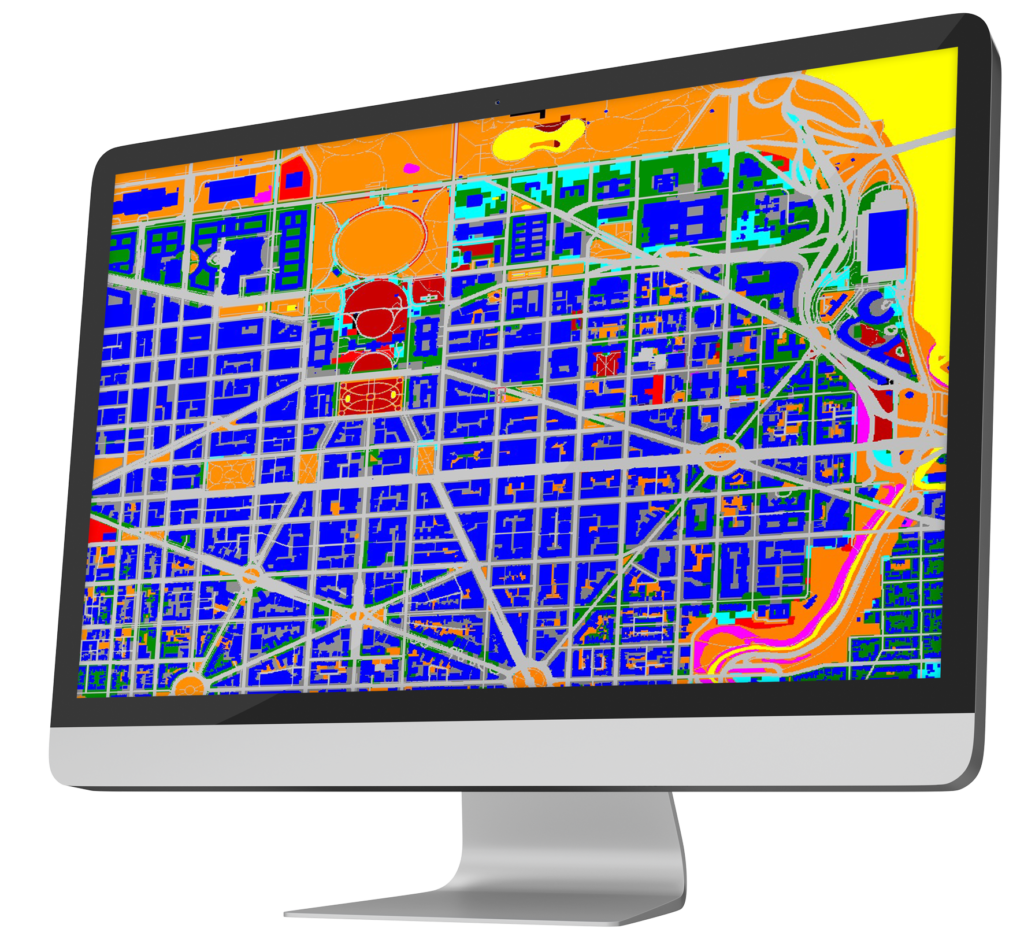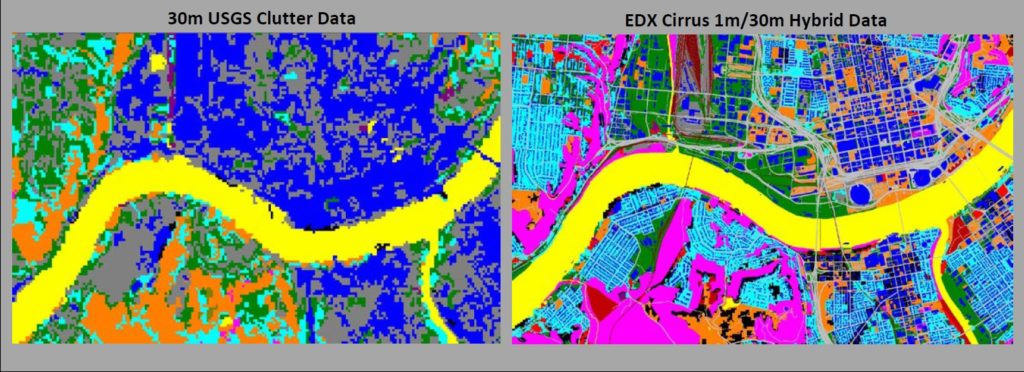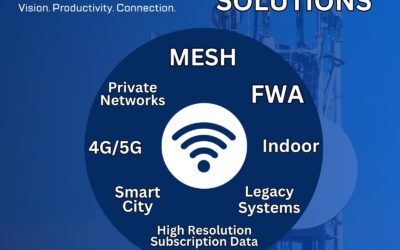EDX Wireless Cirrus is the annual data subscription service for custom high-resolution data. Included in the service are 1m/30m resolution hybrid clutter data, 10m terrain, 2D vectors, demographics and social media data. EDX Cirrus provides regularly updated data, ensuring you have the most current and accurate information available. Annual subscription plans include the continental US, global data or data for a particular service area as defined by one square degree tiles. The service is a cost effective alternative to purchasing data outright.
Land Use (Clutter) Data
When you’re selecting data to use in your service area models, one of the most critical and painstaking tasks is finding an appropriate land use or clutter database. This is important – because as much as terrain elevation can affect propagation, even more impactful is the local features of a service area like structures and foliage. As such, it’s vital to account for these features in our models.
There is a wide range of sources and resolutions for clutter data – and sometimes it can be a challenge determining which will be best suited for our application. One of the problems with finding a good clutter database is that it can get costly. And of course, if data is inaccurate, it can be devastating in our system buildouts. It’s also a concern that clutter data that’s accurate now, may not be months or a year from now, if we’re in an area experiencing a lot of development for example. Then this goes back to cost – how much am I willing to spend on a database that may not be of much use down the road?

The Hybrid Clutter Data Solution
To address these concerns – one of the biggest features of EDX Wireless Cirrus is the 1m/30m hybrid clutter data. Hybrid clutter is different than typical clutter databases because it’s made up of imagery from different sources to provide the highest resolution possible in the areas where it matters most. For example…you would see 1m resolution in dense, urban areas and 30m resolution in rural type areas where the resolution doesn’t matter as much.
Hybrid data has historically provided a cost effective solution to purchasing data – because to purchase a 1m resolution clutter database for any kind of decent sized service area would be very costly. And somewhat paradoxically, paying this high cost for a 1m resolution database would not even provide that much benefit, since in rural areas that don’t have the density of environmental features, a lower resolution will give you the same results.
The hybrid clutter data takes advantage of this concept by providing 1m resolution data where you need it, fills in the rural areas with 30m resolution and the result is an affordable, high-resolution clutter database. The EDX Wireless Cirrus service provides yet another avenue, and even more cost effective method for procuring this data.
Below is an example of the hybrid clutter data vs the 30m resolution USGS data for an area in Cincinnati:

You can see within the hybrid clutter that street canyons and often times individual building footprints are depicted. This level of resolution becomes particularly important with systems that feature transmitters close to ground level. If we’re designing a tall-tower, wide-area network for example, the propagation will not be affected as much by the physical issues of the environment. But as networks have evolved, more devices are getting mounted on poles and on other assets at street level. Plus, networks are becoming more complex…when you think about the nature of AMI networks for example or the Internet of Things – these types of networks are greatly affected by physical issues in the service area and require this level of resolution in a database to be properly modeled.
Accuracy
But resolution is not the only factor when considering clutter databases. Also of great importance is the accuracy in which clutter is categorized – and thereby the proper attenuation values assigned to each area. It’s worth noting that most clutter databases are used in many applications and are not RF specific. The USGS data for example is used for biodiversity conservation, water quality assessment and much more. As such, not all of the assigned clutter categories are relevant when planning a wireless network. For use in a propagation model, the USGS clutter is typically mapped to the 20 categories deemed most relevant to RF planning.
However, this often results in the combining of several categories, meaning blanket attenuation values are applied to several land use areas. In other words, what can occur is that areas such as roads, parking lots and railways may be merged into the same category – when in the real world, obviously these areas will affect propagation much differently.
Consider the below example for an area in Eugene, Oregon. Note that in the hybrid clutter, there is a “park” category that is defined as “low intensity” in the USGS data. Also in the hybrid clutter, we have a railway and parking lot, but these are all jammed into a category of “high intensity” with the USGS.

A custom database such as that found with EDX Cirrus, contains clutter categories specific to RF planning, with an increased level of detail to the different land use areas and appropriate values assigned as such. Not only does the high resolution of the data mean more accurate study results, but you will also have a new level of performance visualization and more information for queries that you may want to run.
Complete and Current
EDX Wireless Cirrus eliminates the risk of purchasing data that may not accurately portray a service area environment in the future. The service provides regularly updated data to reflect changes in developing areas and ensure users are always working with the most current and accurate information. The databases in EDX Wireless Cirrus also receive regular, global updates with new areas consistently being added.
Additionally, each subscription includes everything you need for your models, so it’s not only the clutter we’ve been speaking about but also terrain, demographics, 2D vectors and social media data that are included.
Flexible and Customizable
Custom database layers can be added to the Cirrus service if they are needed. This includes building height and clutter height data for any area. In addition, requests for custom databases outside the scope of EDX Cirrus can typically be accommodated and added to subscription plans.
The available subscription plans make it easy to get data needed for your particular area of interest for the length of a project. Users can subscribe to the entire globe, the US or specific areas for one year only for short-term projects, or several years for long-term use.
EDX Cirrus provides high-resolution, custom and cost effective data that can be used in any existing or new SignalPro project. EDX Cirrus provides everything you need to create a 3D model with a lot of flexibility in how you subscribe and use the service. In providing a new level of accuracy and system performance visualization, EDX Cirrus is an essential part of designing networks as they continue to evolve and get deployed in a variety of challenging service areas.




